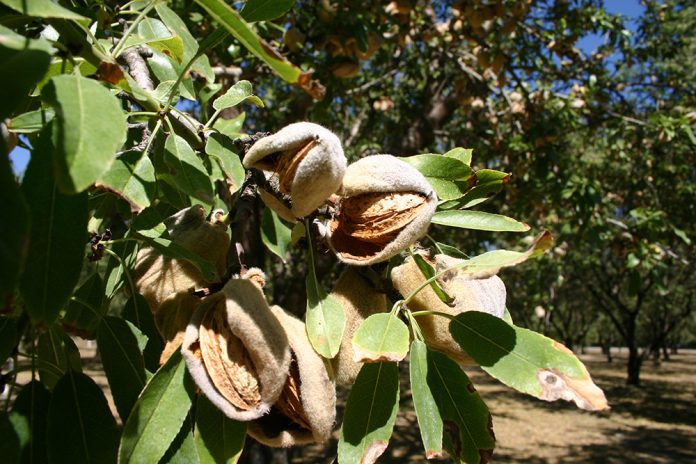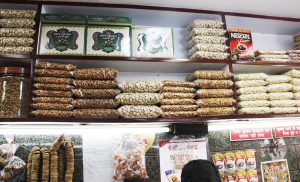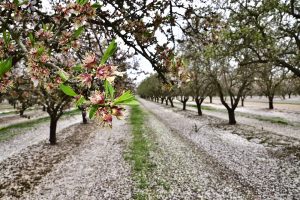
The decline in California almond acreage last year, the first decline in more than 25-years, wasn’t unexpected, given a “trifecta of impacts,” according to Richard Waycott, president and CEO of the Almond Board of California.
Nevertheless, the decline from 1.65 million acres in almonds in 2021 to 1.63 million in 2022, according to figures from the USDA’s National Agricultural Statistics Service (NASS), is notable and has sparked an introspection of where the industry is today, where it has come from and where it may be headed in the future.
In one respect, after so many years of increased acreage, including a significant increase over the last decade, the decline was inevitable, according to ABC Board Member Mel Machado, Vice President of Member Relations for Blue Diamond Growers.
“We had a lot of acres planted in the last 10 years,” Machado said. “It just makes sense that that’s going to slow. It’s not a surprise that that acreage flattens. Not at all.”
“It was in line with most people’s expectations,” Waycott said, “given the economic situations that have befallen agriculture in general, coupled with the drought that we’ve been experiencing and the logistical issues that caused the industry to have this backup of inventory, thereby influencing lower prices in the industry.”
Decline Marks a Milestone
In another respect, while the acreage decline from 2021 to 2022 marks a milestone of sorts, changes in growth patterns for California almonds are nothing new, according to Waycott.
“If you look over the past 20 years, you see these cycles we go through in terms of growth of acreage and then slowdowns,” Waycott said.
“But this one,” he added, “may be more profound and longer lasting than others. We’ve had a sort of trough of pricing that lasted much longer than it typically does. And thinking back over the years, I don’t think we’ve had the combination of factors occurring at the same time, where you have a low price for your product, you have the record costs at the same time, and you have interest rates going up every day or inability to get loans to finance your operations. I don’t think we’ve had that happen to that extent before.”
Waycott also said the USDA’s May 12 estimate that the 2023 almond crop will come in at 2.5 billion pounds, 3% below last year’s 2.57 billion pounds, didn’t offer any surprises.
“A lower crop estimated was not unexpected considering all that growers dealt with last year and during this year’s bloom,” he said. “The cold, wet weather kept bees in their hives and reduced the hours they could pollinate orchards.”
Forecasted yield is 1,810 pounds per acre, down 90 pounds from 2022 and the lowest since 2005.

The Price Effect
Looking back, sources said that much of the acreage increases that occurred over the last two decades can be attributed to good prices. “When prices were good, a lot of acres got planted,” Machado said.
The high prices also allowed growers to keep older orchards in production longer. At the lower prices of today, growers couldn’t afford to do so, Machado said.
“Under higher prices, they could farm older orchards and make it work,” he said. “They were still making some money. But under the current pricing, that no longer works. That was one reason I’ve been hearing for why growers were pulling out orchards.
other reason I’ve been hearing, which is very ironic given this year’s water situation, is ‘I don’t have enough water to farm this thing. I don’t have enough water to sustain it,’” Machado said. “They are looking at their water allocations and deciding to move water onto younger, more productive orchards and taking out the older ones.”
In many cases, particularly in the southern part of the San Joaquin Valley, growers are not replacing almond orchards with new ones, he added, another factor that drew down acreage numbers.
“There are more pistachios going in than anything else in the southern San Joaquin Valley,” Machado said. “You have to look hard to find first-leaf plantings [of almonds] from about Madera south.
“Also, a lot of guys are taking a year off, which is a good thing. Some of these lands have been in almonds for 30, 40 or 50 years,” he said. “So, they are taking a break, doing something different, either letting it fallow or farming another crop, such as a forage if there is a dairy nearby or tomatoes, whatever is available.”

Varietal Changes
The acreage decline, which occurred despite a slight increase in bearing acres, has happened mostly in areas most affected by the drought, so areas like the west side of the San Joaquin and Sacramento valleys, according to figures from Land IQ and USDA-NASS, both of whom the Almond Board contracts with to compile acreage reports.
And the decline has occurred mostly in older varieties that have fallen out of favor because of performance reasons, such as Carmel, Butte and Padre. Butte and Padre, which combined for 11.4% of California almond production in 2014, accounted for just 7% in 2021. Carmel went from 8.5% of production in 2014 to just 4% in 2021.
Self-compatible varieties, conversely, have increased in acreage, particularly Independence, which has risen from less than 0.5% of California almond production in 2014 to 11.5% of the 2021 crop.
Nonpareil continued to be the leading variety in 2022, followed by Monterey and Independence. And Fresno, Kern, Stanislaus, Merced and Madera counties were the leading counties, accounting for 75% of the total bearing acreage.
Looking Ahead
One big question for the industry in light of the 2022 acreage decline is whether this will be but a blip in continued growth or the start of a longer trend.
“I think it will depend on the outcome of the implementation of SGMA as well as the profitability of the industry,” Waycott said. “And we’ve already seen prices improve since the beginning of the year. We’ve seen certain costs decline, such as freight rates and petroleum-based products, such as nitrogen. So, there are some good trends, or reversal-of-trends that are benefiting the industry. And, obviously, this year we will not have a shortage of water. So, that is a good thing.”
“I think we are going to continue to see [acreage] slip or slide down a bit,” Machado said. “I’ve said for many years that water will be our limiting factor for plantings in the future. And now with SGMA looming in the not-too-distant future, I’m sure that will have an impact.
“The question is to what degree and who will be impacted first and where those impacts will occur,” Machado added, “and those questions are largely unanswered, even though it is almost upon us.”
Asked whether last year’s acreage decline is in any way bad for the industry, Machado said, “No, I don’t think so at this point.”Waycott, t
oo, didn’t view the acreage decline as particularly significant.
“I think as long as almonds can retain long-term profitable outlook, growers will want to plant them,” Waycott said. “We’re obviously the best place in the world to grow this product, and that’s been proven over and over.
“And there are many advantages with almonds,” he said. “It is a low-labor industry. It’s not without its issues in terms of crop maintenance and crop protection and so on, but it’s relatively easier to farm than other things. And I think that the marketing machine that’s been developed over the last 30 years at the Almond Board has helped create a powerhouse of an industry that has transformed its product over the last 25 years. So, it’s very well positioned. And per-capita consumption in many parts of the world is still tiny, so there is a lot of room for growth.
“So, I think almonds have a good shot at continuing growth,” Waycott said, “even with the reduced agricultural footprint in California.”










